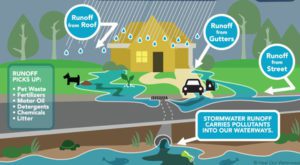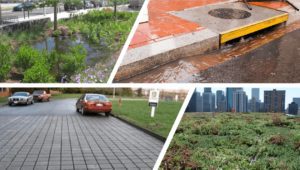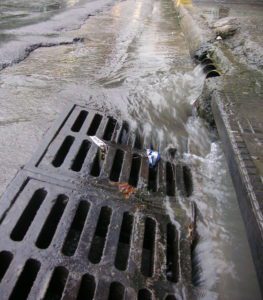Directions
Ask an adult before you take a walk around your neighborhood. They might want to go with you!
On your walk, please stay at least 6 feet from other people you encounter.
Start by walking one square block around your neighborhood, along a sidewalk. Take a notebook or piece of paper with you to record what you observe about surfaces and think about how stormwater runoff is impacted by these surfaces. Try to do this when the ground is dry and then again after it has rained.
Some things to observe
- How many storm drains do you see?
- Where are these storm drains located? On the streets, along the curb, in parking lots, or in a rain garden?
- Are the storm drains labeled? (for example, is there a decal that might say “only rain down the drain!”)
- Do the drains have debris (leaves, litter, etc.) in or around them?
- Name the pervious and impervious surfaces you notice on your walk
- Are there more pervious or impervious surfaces? Can you give a percentage? (“I see more lawns and gardens than I do sidewalks, streets, buildings and parking lots” – 60% pervious and 40% impervious or “There are more buildings, sidewalks, streets, and parking lots than lawns and garden. 30% pervious and 70% impervious )
- Do you notice any litter along your route? What type of trash do you see?
- How many buildings did you see (for example houses, apartments, stores, or offices)?
- How many trees do you see on your walk?
- How many gardens do you see during your neighborhood walk? These could be vegetable gardens or native plant gardens.
- Did you walk near any parks or large fields?
Pre rain Observation (while the ground is dry):
- Do you see any standing water on your walk? On the street, sidewalk, in people’s yards, in parking lots? If so, where? (this is important for a later activity!)
- Are there trees or gardens near the water?
Post rain Observations (after a rainfall):
- Do you see any standing water on your walk? On the street, sidewalk, in people’s yards, in parking lots? If so, where? (this is important for a later activity!)
- Are there trees or gardens near the water?
Share your conclusions
Pretend you are an urban planner (a person who develops plans and programs for the use of land). Your job is to improve stormwater runoff in your neighborhood. Name at least 3 improvements you would make. Take a picture or video, or write them down and send them to us or tag us on Instagram (@resources_protects)!



